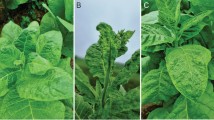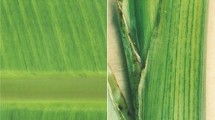Abstract
Fig mosaic disease (FMD) was systemically transmitted to susceptible fig plants by grafting and led to development of symptoms including a wide array of discoloration, green blisters, mottling, crinkling and deformation of leaves and fruits. A sensitive assay for the detection of FMV using specific enzyme-linked immune sorbent assay and reverse transcription-polymerase chain reaction was developed. A double-stranded RNA ca. 19 kbp in size was obtained from the fig tissue extract and used as a template. A cDNA fragment (350 bp) of phosphate motifs 1 and 2 of the heat shock-protein 70 homologue of the family Closteroviridae was amplified using a specific primer set. Virions were flexuous filaments up to 1,800 nm in length and ~21 nm in diameter. Viral infection formed new polypeptides in leaves that reflect pathogen-related proteins. Total photosynthetic pigment contents of virus-infected leaves decreased by 33.06%, with a raise in chl a/b ratio that was mainly caused by a decline in chl b content. Chloroplasts of virus-infected leaves lost their envelopes, and the internal structures of grana and stroma thylakoids were deformed and turned to spherical shapes. No virus inclusion bodies were detected in chloroplasts or other mesophyll cell organelles. Starch grains of chloroplasts were absent in the virus-infected leaves. Viral infection caused a decline in catalase and induction in peroxidase activities in leaves. Levels of thiobarbituric acid reactants in viral-infected leaves increased by 15%, while the content of total phenolics increased by 29%, in respect to healthy ones. The present results indicate a possible presence of Fig leaf mottle-associated virus-1 (FLMaV-1) in fig trees and provide an overview of the negative effects on fig leaves in response to FLMaV-1 infection from morphological, physiological and subcellular perspectives.







Similar content being viewed by others
Abbreviations
- CAT:
-
Catalase
- Chl:
-
Chlorophyll
- cDNA:
-
Complementary deoxy ribonucleic acid
- dsRNA:
-
Double-stranded RNA
- ELISA:
-
Enzyme-linked immune sorbent assay
- FLMaV-1:
-
Fig leaf mottle-associated virus-1
- FMD:
-
Fig mosaic disease
- FMV:
-
Fig mosaic virus
- Hsp70h:
-
Heat shock-protein 70 homologue
- MDA:
-
Malondialdehyde
- PSII:
-
Photosystem II
- POX:
-
Peroxidase
- ROS:
-
Reactive oxygen species
- RT-PCR:
-
Reverse transcription-polymerase chain reaction
- TBARS:
-
Thiobarbituric acid reactants
References
Almási A, Apatini D, Bóka K, Böddi B, Gáborjányi R (2000) BSMV infection inhibits chlorophyll biosynthesis in barley plants. Physiol Mol Plant Pathol 56:227–233
Appiano A, Conti M, Zini N (1995) Cytopathological study of the double-membrane bodies occurring in fig plants affected by fig mosaic disease. Acta Hortic 386:585–592
Arias MC, Lenardon S, Taleisnik E (2003) Carbon metabolism alterations in sunflower plants infected with the Sunflower chlorotic mottle virus. J Phytopathol 151:267–273
Bolwell GP, Bindschedler LV, Blee KA, Butt VS, Davies DR, Gardner SL, Gerrish C, Minibayeva F (2002) The apoplastic oxidative burst in response to biotic stress in plants: a three-component system. J Exp Bot 53:1367–1376
Buchanan-Wollaston V (1997) The molecular biology of leaf senescence. J Exp Bot 48:181–191
Cai YZ, Luo Q, Sun M, Corke H (2004) Antioxidant activity and phenolic compounds of 112 traditional Chinese medicinal plants associated with anticancer. Life Sci 74:2157–2184
Candela ME, Munoz R, Alcázar MD, Espín A (1994) Isoperoxidase involvement in the resistance of Capsicum annuum to infection by cucumber mosaic virus. J Plant Physiol 143:213–217
Chandlee JM, Scandalios JG (1984) Analysis of variants affecting the catalase development program in maize scutellum. Theor Appl Genet 69:71–77
Chaoui A, Mazhoudi S, Ghorbal MH, El Ferjani E (1997) Cadmium and zinc induction of lipid peroxidation and effects on antioxidant enzyme activities in bean (Phaseolus vulgaris L.). Plant Sci 127:139–147
Chen ZX, Silva H, Klessig DF (1993) Active oxygen species in the induction of plant systematic acquired-resistance by salicylic acid. Science 262:1883–1886
Clark MF, Adams AN (1977) Characteristics of the microplate method of enzyme-linked immunosorbent assay for the detection of plant viruses. J Gen Virol 34:475–483
Clarke SF, Guy PL, Burritt DJ, Jameson PE (2002) Changes in the activities of antioxidant enzymes in response to virus infection and hormone treatment. Physiol Plant 114:157–164
Costa RM, Magalhães AS, Pereira JA, Andrade PB, Valentão P, Carvalho M, Silva BM (2009) Evaluation of free radical-scavenging and antihemolytic activities of quince (Cydonia oblonga) leaf: a comparative study with green tea (Cammelia sinensis). Food Chem Toxicol 47:860–865
Dai GH, Andary C, Cosson-Mondolot L, Boubals D (1994) Polyphenols and resistance of grapevines to downy mildew. Acta Hortic 381:763–766
Díaz-Vivancos P, Clemente-Moreno JM, Rubio M, Olmos E, García JA, Martínez-Gómez P, Hernández JA (2008) Alteration in the chloroplastic metabolism leads to ROS accumulation in pea plants in response to plum pox virus. J Exp Bot 59:2147–2160
Dolja VV (2003) Beet yellows virus: the importance of being different. Mol Plant Pathol 4:91–98
Elbeaino T, Digiaro M, De Stradis A, Martelli GP (2006) Partial characterisation of a closterovirus associated with a chlorotic mottling of fig. J Plant Pathol 88:187–192
Elbeaino T, Digiaro M, De Stradis A, Martelli GP (2007) Identification of a second member of the family Closteroviridae in mosaic-diseased figs. J Plant Pathol 89:119–124
Elbeaino T, Digiaro M, Alabdullah A, De Stradis A, Minafra A, Mielke N, Castellano MA, Martelli GP (2009a) A multipartite single-stranded negative-sense RNA virus is the putative agent of fig mosaic disease. J Gen Virol 90:1281–1288
Elbeaino T, Digiaro M, Martelli GP (2009b) Complete nucleotide sequence of four RNA segments of fig mosaic virus. Arch Virol 154:1719–1727
Elvira MI, Galdeano MM, Gilardi P, García-Luque I, Serra MT (2008) Proteomic analysis of pathogenesis-related proteins (PRs) induced by compatible and incompatible interactions of pepper mild mottle virus (PMMoV) in Capsicum chinense L3 plants. J Exp Bot 59:1253–1265
Falk BW, Tsai JH (1984) Identification of single and double stranded RNAs associated with maize stripe virus. Phytopathol 64:909–915
FAO (2006) FAOSTAT agricultural data. http://faostat.fao.org/site/408/default.aspx. Accessed Aug 2006
Guevara-Morato MA, de Lacoba MG, García-Luque I, Serra MT (2010) Characterization of a pathogenesis-related protein 4 (PR-4) induced in Capsicum chinense L3 plants with dual RNase and DNase activities. J Exp Bot 61:3259–3271
Harper K, Kreamer R (1995) Hybridization detection of insect-transmitted plant viruses with digoxigenin-labeled probes. Plant Dis 78:563–567
Hernández JA, Almansa MS (2002) Short-term effects of salt stress on antioxidant systems and leaf water relations of pea leaves. Physiol Plant 115:251–257
Hernández JA, Rubio M, Olmos E, Ros-Barcelo A, Martinez-Gomez P (2004) Oxidative stress induced by long-term plum pox virus infection in peach (Prunus persica). Physiol Plant 122:486–495
Jensen SG, Lane LC, Seifers DL (1996) A new disease of maize and wheat in the high plains. Plant Dis 80:1387–1390
Karasev AV (2000) Genetic diversity and evolution of closteroviruses. Annl Rev Phytopathol 38:293–324
Kofalvi SA, Nassuth A (1995) Influence of wheat streak mosaic virus infection on phenylpropanoid metabolism and the accumulation of phenolics and lignin in wheat. Physiol Mol Plant Pathol 47:365–377
Kuroda M, Ozawa T, Imagava H (1990) Changes in chloroplast peroxidase activities in relation to chlorophyll loss in barley leaf segments. Physiol Plant 80:555–560
Laemmli UK (1970) Cleavage of structural proteins during the assembly of the head of bacteriophage T4. Nature 227:680–685
Léon J, Lawton MA, Raskin I (1995) Hydrogen peroxide stimulates salicylic acid biosynthesis in tobacco. Plant Physiol 108:1673–1678
Li Z, Burritt DJ (2003) The influence of Cocksfoot mottle virus on antioxidant metabolism in the leaves of Dactylis glomerata L. Physiol Mol Plant Pathol 62:285–295
Lichtenthaler HK (1987) Chlorophylls and carotenoids–pigments of photosynthetic biomembranes. In: Colowick SP, Kaplan NO (eds) Methods in enzymology, vol 148. Academic Press, San Diego, pp 350–382
Lin CC, Kao CH (2000) Effect of NaCl stress on H2O2 metabolism in rice leaves. Plant Growth Regul 30:151–155
Mars M (2003) Fig (Ficus carica L.) genetic resources and breeding. Acta Hortic 605:19–27
Martelli GP, Castellano MA, Lafortezza R (1993) An ultrastructural study of fig mosaic. Phytopathol Mediterr 32:33–43
Milavec M, Ravnikar M, Kovač M (2001) Peroxidases and photosynthetic pigments in susceptible potato infected with potato virus YNTN. Plant Physiol Biochem 39:891–898
Nahdi S, Elbeaino T, Digiaro M, Martelli GP (2006) First record of fig leaf mottle-associated virus 1 in Tunisia. J Plant Pathol 88:S70
Nanda RM, Biswal B (2008) Biotic stress induced demolition of thylakoid structure and loss in photoelectron transport of chloroplasts in papaya leaves. Plant Physiol Biochem 46:461–468
Oliveira AP, Valenão P, Pereira JA, Silva BM, Tavares F, Andrade PB (2009) Ficus carica L.: Metabolic and biological screening. Food Chem Toxicol 47:2841–2846
Otulak K, Garbaczewska G (2010) Localisation of hydrogen peroxide accumulation during Solanum tuberosum cv. Rywal hypersensitive response to Potato virus Y. Micron 41:327–335
Polle A, Otter T, Seifert F (1994) Apoplastic peroxidases and lignifications in needles of Norway Spruce Picea abies L. Plant Physiol 106:53–60
Radwan DEM, Fayez KA, Mahmoud SY, Hamad A, Lu G (2006) Salicylic acid alleviates growth inhibition and oxidative stress caused by zucchini yellow mosaic virus infection in Cucurbita pepo leaves. Physiol Mol Plant Pathol 69:172–181
Radwan DEM, Fayez KA, Mahmoud SY, Hamad A, Lu G (2007) Physiological and metabolic changes of Cucurbita pepo leaves in response to zucchini yellow mosaic virus (ZYMV) infection and salicylic acid treatments. Plant Physiol Biochem 45:480–489
Radwan DEM, Fayez KA, Mahmoud SY, Hamad A, Lu G (2010) Modifications of antioxidant activity and protein composition of bean leaf due to Bean yellow mosaic virus infection and salicylic acid treatments. Acta Physiol plant 32:891–904
Rahoutei J, Garcia-Luque I, Baron M (2000) Inhibition of photosynthesis by viral infection: effect on PSII structure and function. Physiol Plant 110:286–292
Reinero A, Beachy RN (1989) Reduced photosystem II activity and accumulation of viral coat protein in chloroplasts of leaves infected with tobacco mosaic virus. Plant Physiol 89:11–16
Riedle-Bauer M (2000) Role of reactive oxygen species and antioxidant enzymes in systemic virus infections of plants. J Phytopathol 148:297–302
Saldarelli P, Minafra A, Martelli GP, Walter B (1994) Detection of grapevine leafroll associated closterovirus III by molecular hybridization. Plant Pathol 43:91–96
Serrano L, Ramon J, Segarra J, Medina V, Achón MA, López M, Juárez M (2004) New approach in the identification of the causal agent of fig mosaic disease. Acta Hortic 657:559–566
Spurr AR (1969) A low viscosity epoxy resin embedding medium for electron microscopy. J Ultra Res 26:31–43
Stover Ed, Aradhya M, Ferguson L, Crisosto CH (2007) The fig: overview of an ancient fruit. Hortic Sci 42:1083–1087
Synková H, Semorádová Š, Schnablová R, Müller K, Pospíšilová J, Ryšlavá H, Malbeck J, Čeřovská N (2006) Effects of biotic stress caused by Potato virus Y on photosynthesis in ipt transgenic and control Nicotiana tabacum L. Plant Sci 171:607–616
Técsi L, Smith AM, Maule AJ, Richard C (1996) A spatial analysis of physiological changes associated with infection of cotyledons of marrow plants with cucumber mosaic virus. Plant Physiol 111:975–985
Tzanetakis IE, Martin RR (2007) Strawberry chlorotic fleck: identification and characterization of a novel Closterovirus associated with the disease. Virus Res 124:88–94
van Loon LC (1985) Pathogenesis-related proteins. Plant Mol Biol 4:111–116
van Loon LC (1997) Induced resistance in plants and the role of pathogenesis-related proteins. Eur J Plant Pathol 103:753–765
Veberic R, Colaric M, Stampar F (2008) Phenolic acids and flavonoids of fig fruit (Ficus carica L.) in the northern Mediterranean region. Food Chem 106:153–157
Walia JJ, Salem NM, Falk BW (2009) Partial sequence and survey analysis identify a multipartite, negative-sense RNA virus associated with fig mosaic. Plant Dis 93:4–10
Wojtaszek P (1997) Oxidative burst: an early plant response to pathogen infection. Biochem J 322:681–692
Yalpani N, León J, Lawton MA, Raskin I (1993) Pathway of salicylic acid biosynthesis in healthy and virus-inoculated tobacco. Plant Physiol 103:315–321
Author information
Authors and Affiliations
Corresponding author
Additional information
Communicated by B. Barna.
Rights and permissions
About this article
Cite this article
Fayez, K.A., Mahmoud, S.Y. Detection and partial characterization of a putative closterovirus affecting Ficus carica: molecular, ultrastructural and physiological aspects of infected leaves. Acta Physiol Plant 33, 2187–2198 (2011). https://doi.org/10.1007/s11738-011-0758-0
Received:
Revised:
Accepted:
Published:
Issue Date:
DOI: https://doi.org/10.1007/s11738-011-0758-0




